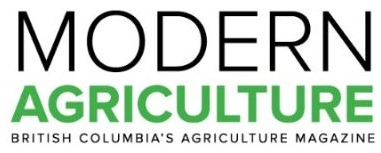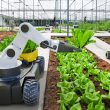Dr. Steph Rhebergen is a large animal veterinarian with Abbotsford Veterinary Clinic and practicing animal acupuncturist. She has treated small and large animals, and taken additional, acupuncture specific courses to earn her CVA (Certified Veterinarian Acupuncturist).
“The Chi Institute in Reddick [Florida] is where I did my training,” says Dr. Rhebergen, en route to a nearby dairy farm—one of her four regular AP clients. She studied under a master at the Chi Institute who treated snakes, lizards, elephants and other exotic animals; but what piqued Dr. Rhebergen’s interest was bovine AP.
Using acupuncture on animals isn’t new science, just to “us Westerners,” quips Dr. Rhebergen. In reality, this science has been evolving for the last 3,000 years, originating in China. People are more aware of using acupuncture on horses, especially performance horses, rather than cows. However, today’s client became aware of bovine AP via successful treatments Dr. Rhebergen administered to their two show horses.
Arriving on the farm, Dr. Rhebergen admits that the client base for bovine AP is not huge, but it is slowly and steadily growing, especially among organic dairies.
This natural treatment never requires milk withdrawal and has been shown to even boost milk production after a session.
“I had an acupuncture trial going on with an organic farm and it was helping with cysts,” explains Dr. Rhebergen. Organic dairies have greater restrictions when it comes to using on-farm medications. The outcome was promising for both her and the farmer.
“We had three out of five [cows] that responded to the acupuncture and they are now pregnant, so that was a good result,” the farmer explained.
Dr. Rhebergen has also used AP on down cows to treat lameness, stimulate appetite and decrease swelling and pain from acute injuries.
“If you can get on those [acute injuries] right away with acupuncture they heal a lot quicker than just giving them a shot of medicine. After a couple of days of acupuncture they don’t need medication because the results are quite powerful.”
Dr. Rhebergen’s first client of the day—a large Holstein cow—fidgets as the first thin four-inch needle is pressed down along her spine. The depth of each needle depends on the condition of the cow, and location is based on the diagnosis. The cow won’t be sedated since sedation reduces AP effectiveness by 25%. As the session continues, the cow becomes increasingly calmer. Her discomfort seems to be no worse than if she was contending with flies in the summertime.
Dr. Rhebergen also carries an AP arsenal with her. Snapping open the hard case, she reveals that acupuncture methods have evolved beyond needles. Her array of tools include a moxa stick—which smolders (when lit), resembling a thick, white cigar—as well as an electro-acupuncture box. This box has a tangle of mini cables twisting away from it with clips at the ends which Dr. Rhebergen fastens to the needles. The setup appears similar to jumper cables and, when switched on, emits electric shocks.
“The lower frequency,” explains Dr. Rhebergen, “is 20 hertz and it stimulates the release of endorphins, the body’s natural painkillers. Eighty to 120 hertz stimulates serotonin release which helps internal organs to heal.”
The moxa stick—which is packed with herbs—is purposefully designed to burn at a high temperature, resulting in moxibustion. When the stick is held over individual needles, it heats the needle, consequently stimulating that acupoint. These two methods—the moxa stick and electro-box—are not done at the same time but, if the case requires it, one after the other.
The session for one cow lasts approximately half an hour. For this case, Dr. Rhebergen did not need to use her low-level light therapy laser or inject vitamin B12 into the points, which creates a longer lasting effect. The laser can be rented by farmers which allows them to treat a condition twice daily, on weekends or when at a cattle show. This gives the farmer flexibility for treatments, helps minimize healing time and saves money with fewer farm calls.
The price for a single bovine AP treatment can vary from $85-$145 with additional cost for the call fee. This price range is the result of numerous variables like the diagnosis and session length. Most cows only require two or three sessions while some down cows may need four or five.
Bovine AP does not mark the end of on-farm medications. Dr. Rhebergen cites AP as a “complementary medicine” to current on-farm practices. However, there have been cases that she treated solely with Chinese herbs, ginger, cayenne pepper and probiotics. Dr. Rhebergen used the herbals and AP to get a cow’s stomach moving and settle diarrhea without using antibiotics.
“Acupuncture is a dynamic process. There is no right or wrong answer but usually after the second or third treatment, if there is no improvement, it is usually something structural. It depends on the case. If they’ve had the issue for a long time it will take longer to clear out.”
The American Association of Traditional Chinese Veterinary Medicine (AATCVM) provides a brief explanation on their website on animal AP. AATCVM explains that the placing of needles at specified acupoints stimulates local nerve reflexes, positively affecting local structures and internal organs near these points. AP can even be used to stimulate the brain and initialize changes in hormones and chemicals throughout the body. This allows the animal’s healing and regeneration processes to function at their best. Also, some AP treatments can even eliminate the need for surgery, avoiding additional cost and risk.
There have been more AP studies done on small animals and horses, with fewer bovine cases. The studies that have been done—predominately in China—need to be translated into English, which is a hurdle in itself without considering all the scientific jargon. There are some studies on bovine AP and its effect on somatic cell count and displaced abomasum but not enough. Abbotsford Veterinary Clinic is also embarking on their own AP review, since they are currently the only clinic in British Columbia offering bovine AP treatments.
“It’s a good practice builder,” states Dr. Rhebergen who was already performing animal AP before she joined the clinic. “It has promising results so they were more than happy to go with it!”












